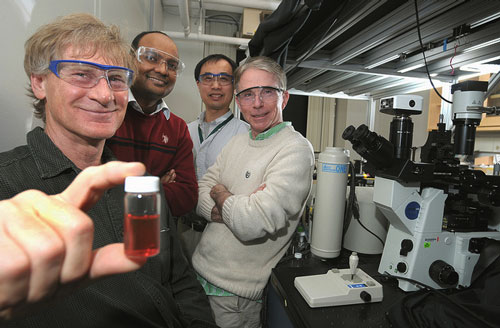| Mar 18, 2011 |
Scientists use light to join nanoparticles into new materials
|
|
(Nanowerk News) For many years, scientists have searched for ways to assemble nanoparticles—tiny bits of matter less than a millionth of an inch across—into larger structures of any desired shape and form at will. This effect has been achieved in a new study by using a laser as if it were a magic wand, creating an assembled, continuous filament as the laser beam is moved around.
|
|
"It's possible that we could use this method to encapsulate pharmaceutical agents for new drug delivery systems or build cathodes with very large surface areas for use in batteries," said Argonne biophysicist John Bahns, who led the invention of the technology. "It could potentially help us find better materials that could be used in everything from catalysts to semiconductors; the possibilities are endless."
|
|
Researchers at Argonne National Laboratory shined a low-power laser—similar in intensity to ones used in office laser pointers—into a solution of gold and carbon nanoparticles suspended in water. Unexpectedly, they found that the carbon nanoparticles decomposed or deformed to create a kind of "glue" that enabled the creation of long gold and carbon chains that assembled continuously wherever the laser was pointed.
|
 |
| John Bahns, Subramanian Sankaranarayanan, Liaohai Chen and Stephen Gray find new way to assemble nanoparticles.
|
|
This new technique for materials design, known as "optically directed assembly" or ODA, could provide scientists and inventors with an uncharted route to new materials, technologies and even treatments for diseases. "It's incredibly exciting to think about the vast world of technology that could result from people using ODA," said Liaohai Chen, who helped to develop the technology. "This is just the very beginning; we really don't even know yet all the things that might be possible."
|
|
The research leading to the discovery of ODA sought to develop new methods for imaging dynamic biological processes in living systems. "ODA provides a new way to encapsulate metal particles with inert carbon, which can be harnessed to generate imaging probes for studies of biological systems important to bioenergy research or medical diagnostics," Chen said. "ODA opens a new avenue to synthesize a new generation of nanoparticle-based imaging probes (especially for the metal isotopes) and therapeutic agents with a simple, inexpensive, safer and greener (energy efficient) process" said Chen.
|
|
"It could potentially help us find better materials that could be used in wide application spectrum ranging from catalysts, drug delivery to semiconductors," said Bahns.
|
|
The difference between ODA and other light-based experiments in materials design lies in the fact that ODA involves the creation of what Chen called a "structure within a structure." Rather than creating a completely continuous material like a sheet of aluminum foil, ODA forms a larger coherent structure from the individual nanoparticles. "You can think of it like going to the beach and pointing a stick at the sand," Chen said, "and then all of a sudden having pebbles gather and join together wherever you decided to point the stick."
|
|
"The laser basically acts kind of like a pen, as opposed to a stylus, creating a thread of gold and carbon as it's moved along," added Argonne nanoscientist Subramanian Sankaranarayanan, who collaborated on the research. "It surprised us that such a low-power laser could have such a big effect."
|
|
Sankaranarayanan and Stephen Gray of Argonne's Center for Nanoscale Materials have also developed a predictive computational model of the ODA phenomenon.
|
|
Optically directed assembly works because the laser heats up the spot onto which it is focused, causing a phenomenon known as "convective flow" in which the solution travels around the hot spot. The action of the flow combined with laser heating brings the particles together, creating the filaments.
|
|
The discovery of the ODA technique happened completely by accident. Bahns and Chen were investigating carbon in soil by using a technique called Raman spectroscopy.
|
|
The researchers added gold nanoparticles to their sample because these particles are known to boost Raman signals. Because Raman spectroscopy requires the use of a laser, the researchers surprisingly found that gold-carbon chains would form wherever they moved the laser. "It looked almost like an Etch-a-Sketch," Chen said.
|
|
Based on the researchers' observations, ODA can also provide a new way to encapsulate metal particles with inert carbon, which researchers believe will eventually allow for the creation of new probes that would investigate the uptake of different molecules by both human and plant tissues.
|
|
According to Gray, ODA helps to bridge a gap that has existed in materials design between structures of different sizes. "There's a grand challenge to extend nanoscale phenomena to the millimeter level," Gray said. "ODA works best in the region between the two called the 'mesoscale,' and so we believe that we have a lot of different opportunities to explore with it."
|
|
An article based on the study appeared in the February 28 edition of Physical Review Letters. Funding for the study was provided by the U.S. Department of Energy's Office of Science.
|
|
The Center for Nanoscale Materials is one of the five DOE Nanoscale Science Research Centers, premier national user facilities for interdisciplinary research at the nanoscale supported by the DOE Office of Science. Together the NSRCs comprise a suite of complementary facilities that provide researchers with state-of-the-art capabilities to fabricate, process, characterize and model nanoscale materials, and constitute the largest infrastructure investment of the National Nanotechnology Initiative. The NSRCs are located at DOE's Argonne, Brookhaven, Lawrence Berkeley, Oak Ridge, Sandia and Los Alamos National Laboratories. For more information about the DOE NSRCs, please visit http://nano.energy.gov.
|

